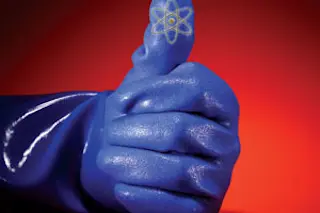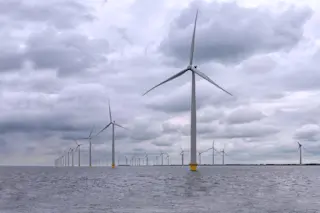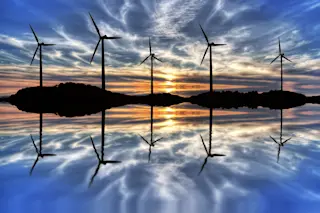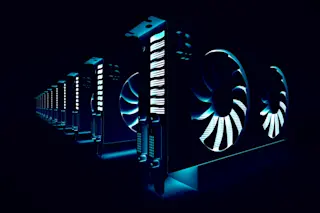I’m standing 20 feet from the brightly glowing core of a laboratory nuclear test reactor the size of a van, and the Geiger counter next to me is going nuts. But no worries, I’m told. The light, visible on a nearby monitor hooked up to a camera inside the reactor, is not from nuclear fission; it is harmless emission from electrons zipping out of the core and shedding their energy into the water that surrounds it. And the stream of particles eliciting the shriek from the Geiger counter is not from the reactor at all. Just for a giggle, the reactor manager has placed the detector next to a Fiestaware cup, which happens to be one of many everyday items that are mildly radioactive. He keeps it on hand to tease visitors. I am actually getting less radiation here than I would on the beach or in an airplane.
You’ll have to forgive the folks at Oregon State University’s Radiation Center for having a little fun. Nuclear power fell into a long funk after the partial core meltdown at the Three Mile Island reactor in Pennsylvania in 1979. All new nuclear plant construction in the United States came to a halt, and before the industry could recover, the 1986 reactor breach at the Chernobyl nuclear plant in Ukraine seemed to seal the fate of nuclear power in this country. Now the technology is hot again—this time in a good way—because it produces virtually no carbon emissions and it backs us away from the turbulent politics and economics of oil.
OSU’s nuclear engineers are basking in that glow. While the industry was in deep freeze, they were pressing ahead with one of the most promising emerging technologies in energy: micro-size nuclear reactors, fully functional power plants a good deal closer to the size of the test reactor I’m standing near. It is a far cry from the standard nuclear plant—the size of a small town, cranking out enough electricity to power a major city—not to mention the even bigger plants going up in China and France.
Given the economies of scale in the power industry, why would anyone want to go teeny? “There are economies of small, too,” says Jose Reyes, chairman of OSU’s nuclear engineering department and chief technology officer at nearby NuScale Power, a commercial spin-off of the department. For one thing, Reyes explains, miniaturized nuclear plants are small enough to mass-produce, driving down costs, and they can be shipped just about anywhere by truck or boat, even to locations that are off the grid. Also, micro nukes can be designed to run a long time without maintenance or refueling. They could be sealed like a big battery and buried underground for as long as three decades, so terrorists could not get into them and nuclear waste could not get out. A spent micro nuke could simply be plucked out of the ground and shipped whole to a waste-processing or recycling facility anywhere in the world; the old one could be swapped out for a new one, cartridge-style. In contrast, a conventional nuclear plant requires several years of customized design and construction, and at the end of its life several years more are needed to dismantle it and decontaminate the massive site around it. Toshiba, Hyperion Power Generation, Sandia National Labs, and TerraPower—a company underwritten in part by Bill Gates—also have downsized nuclear reactor concepts in the works.
Initially, micro nukes are likely to be installed in clusters as safer, simpler replacements for existing commercial reactors that need decommissioning. But in the coming decade, nukelets like NuScale’s may well eclipse solar and wind as the green energy of choice, bringing plentiful electricity to billions of people who lack it and possibly powering individual neighborhoods within cities.
NuScale’s reactor stands to be the first of the new-age nuclear power plants to come on line. Like mainstream reactors, it is a “light water” design: The reactor is pressurized and filled with plain water that flows past the core, where the radioactive decay of uranium-235 generates intense heat. The heat boils a separate tank of water and turns it to steam, which in turn drives turbines that produce electricity. But there are differences. A conventional plant requires a vast, complex array of pumps, pipes, and valves to move enormous quantities of water between the reactor vessel, a separate steam-generating chamber, and a cooling tank. NuScale keeps things simpler with a tall, thin, single-vessel design. Water heated by the core ascends in a chimneylike metal structure inside the reactor, then spills over the top of the chimney and sinks back down along the inside walls of the reactor to repeat the journey. High pressure inside the reactor prevents the superheated water from boiling. As the water climbs over the top of the chimney in the NuScale reactor, it passes over a long coil of pipe, transferring much of its heat to water inside the coil. Lower pressure in the coil allows the water to boil, and the resulting steam travels up the pipe to power a turbine.
This simplified design is as efficient as that of a conventional nuclear plant. NuScale claims it will be able to produce power at about seven to nine cents per kilowatt-hour—roughly the same as big nuclear plants, only a few cents more than the cheapest modern natural gas–fired or coal-fired plants, and one-third the cost of a typical diesel generator. Michael Corradini, who heads the nuclear engineering program at the University of Wisconsin in Madison, notes that while the economics of micro nukes make sense, the biggest advantage to the approach may be that there is so little to go wrong with it. “The NuScale design has a lot of inherent safety, and that makes it very appealing,” he says.

OSU houses a one-third-scale test version of the NuScale reactor, faithful to the real thing except for electrically powered heating rods that stand in for the radioactive core. Operating since 2008, the uncomplicated-looking contraption seems like the sort of thing you would expect to find at the back of a small brewpub. But the device runs like a top, sending a copious river of steam into the air above the building. (Reyes nixed a student scheme to dye the steam green and hook it up to a train whistle.)
NuScale plans to submit its design to the U.S. Nuclear Regulatory Commission in early 2012. The NRC is expected to take at least three years to approve it, due to a backlog of applications at the agency and to the newness of micro nuke designs. Still, that is probably a few years sooner than most other micro nukes can expect to get the nod; the NuScale reactor’s light-water technology is quite similar to the industry-standard approach with which the NRC is intimately familiar. To speed things up further, NuScale is initially marketing its micro nukes in bundles of 12 set up to replace existing nuclear power plants—which means that the company will not have to wait for approval of specific sites, since the go-ahead will already be in place. Having an installed base of safely operating reactors should make it easier to win approval for selling the units individually or in smaller bundles later on, Reyes contends. “We’ll learn a huge amount about building and running the reactors every time we produce a batch of 12,” he says. NuScale is in active discussions with several utility customers.
Sticking with proven light-water technology has some downsides, Reyes acknowledges. To keep the water from boiling and losing its heat-transferring properties, light-water reactors cannot run at the high temperatures that are most efficient for producing power. And even at lower temperatures, preventing boiling requires high pressure. In the unlikely event that an overheating core causes a reactor breach, the pressure could potentially cause an explosive venting of radioactive gases into the environment.
To get around these problems, Japan’s Toshiba and Hyperion Power Generation of Santa Fe, New Mexico, are pushing rival micro reactors. Their versions, which have been in development for more than a decade, use circulating molten metal—sodium and lead bismuth, respectively—as coolants and heat conduits instead of water. Without the risk of water boiling, the reactors can run at higher temperatures, producing enough heat to extract hydrogen from water for use in fuel cells. And if one of these reactors melted open, there would be no venting, just a well-contained hot mess underground.
Toshiba’s 10-megawatt reactor design promises to be a marvel of low maintenance. It is intended to be sealed and run for up to 30 years without refueling, relying on uranium enriched to nearly 20 percent uranium-235. (Typical reactors use a mix that is only about 5 percent energy-rich uranium-235; the rest is more common uranium-238.) Hyperion’s 25-megawatt prototype, which is based on technology developed at nearby Los Alamos National Laboratory and is similar to reactors long used on Russian submarines, gets by with more conventional levels of uranium enrichment but could still run 8 to 10 years without refueling. One big disadvantage to the liquid-metal reactors: Their novel design could require more study by the NRC, potentially adding two or more years to the approval process.
Micro nukes cannot match the cost of electricity from natural gas or coal in areas where these fuels are cheap. But their economics would really shine for isolated towns whose lack of access to central power grids has forced them to rely on dirty and costly-to-run diesel generators. In the United States that especially means Alaska: The town of Galena has a loose agreement with Toshiba to become an early customer, and both Hyperion and NuScale say they, too, have been speaking to communities in the state.
As pressure mounts to cut fossil fuel consumption, and as punitive taxes on non-green power kick in over the next several years, micro nukes could reach a wider market. They are more reliable than wind power and cheaper than solar. They would be much easier to plan, site, set up, and operate than conventional nuclear plants, which currently are hard-pressed to attract investor support in this country. And micro nukes could appeal to companies—computer data centers, factories, financial institutions, hospitals, and the like—that now spend millions of dollars on diesel generators and banks of batteries as back-up to avoid a disastrous loss of power. These benefits take on extra weight in much of Europe, Asia, and other parts of the world where fossil fuels are far costlier than in the United States.
For all their appeal, micro nukes carry some of the same drawbacks that have paralyzed the nuclear power industry in this country. For one thing, a bundle of micro nukes would collectively produce just as much nuclear waste as a conventional plant generating the same amount of power. “They produce less waste per plant but not less waste per unit of energy produced, so it’s not necessarily an advantage,” Corradini says. And no nuclear reactor can ever be 100 percent safe. The NRC currently requires only that the builder prove that the chance of a meltdown for a given reactor in a given year is less than 1 in 10,000.
Then again, nuclear advocates point out that there are plenty of problems associated with fossil fuel emissions —and not just from carbon dioxide. A widely cited Clean Air Task Force report found that power-plant pollution cuts short the lives of 24,000 Americans per year. U.S. Energy Secretary Steven Chu has come out in favor of government backing of small nuclear plants. Tiny nukes could particularly improve the quality of life in impoverished regions that otherwise would not have clean, affordable options for electricity. Hyperion CEO John Deal insists that micro nukes will drastically reduce misery, disease, and poverty throughout the developing world by powering water-treatment systems (as well as lights, sewing machines, and everything else electrical) at less cost than a diesel generator.
“We’re in this to clean the water,” Deal says. “These reactors just happen to be the best way to do it.”















